How to Start a Health Blog: A Step-By-Step Guide
Starting a health and wellness blog enables you to share your passion and expertise, help others live more healthily, and establish yourself as an authority in the field.
Finally, running a health blog can be an excellent way of making money.
This step-by-step guide will walk you through the process of creating, customizing, and monetizing a health blog, from understanding your audience to optimizing your content for search engines.
We will also share tips on how to utilize Hostinger Website Builder to create your online health and wellness space, promote it, and start earning from it.
How to Start a Health Blog
Follow the below steps to go from an idea to a fully-fledged wellness blog:
1. Understand Your Audience
The first step to creating a successful health blog is identifying your target audience. This way, you can tailor your content to meet their needs and interests, which can lead to higher engagement rates, loyal followers, and more opportunities for monetization.
Tips to Get Started
- Identify your blog’s purpose. Decide whether your blog will be educational, motivational, or informational. This will help you focus your content strategy. Educational blogs provide tips on nutrition, exercise, and mental health. Motivational health bloggers share personal health journeys and success stories, and informational ones report on the latest health trends and research.
- Research your audience. Use tools like Google Analytics and gather social media insights and surveys to understand the demographics, interests, and pain points of your potential readers.
- Create reader personas. Develop detailed profiles of your ideal readers, including their age, gender, occupation, and health goals. This will help you write blog posts that offer solutions to their potential problems.
2. Select a Blogging Platform
Choosing the right platform helps transform your blog into a powerful resource for educating and inspiring health enthusiasts worldwide.
Key factors to consider when selecting a blogging platform include:
- Ease of use. Especially important for beginners, a user-friendly interface simplifies setting up and managing your blog. Look for a drag-and-drop website builder to make the experience straightforward and hassle-free.
- Customization. Your blog should reflect your brand identity. Opt for platforms that offer a wide range of themes and design options to create a visually appealing site that resonates with your target audience.
- SEO support. Search engine optimization (SEO) is essential for making your blog discoverable online. Choose a platform with built-in SEO tools and guides to help you optimize your content effectively for search engines.
- Responsiveness. Ensure your blog looks great on all devices by selecting a platform that offers mobile-responsive templates. This guarantees a positive user experience for all visitors, regardless of the device they use.
- Cost. Be mindful of the costs associated with your chosen platform. If you’re on a tight budget, consider platforms that offer affordable plans to get your blog started.

Hostinger Website Builder is an excellent choice for launching a health and wellness blog quickly and easily. It provides all the essential tools you need in a single, intuitive platform starting at just £2.59/month.
Our builder offers 150 professionally designed and fully customizable templates. These website templates enable you to effortlessly set up a new health blog that reflects your passion and brand identity.
With an intuitive drag-and-drop interface, creating a visually appealing website is simple and requires no coding skills. This frees up your time to focus on creating engaging content and sharing your health expertise.
You can also improve your blog’s visibility with integrated SEO tools, helping you attract a dedicated audience searching for health advice and information.
All websites built with Hostinger Website Builder are also mobile-optimized by default. This ensures that your blog provides a seamless user experience across all devices.
Our platform also includes AI-powered tools to streamline your blogging efforts. These tools can suggest content topics, optimize your posts for better SEO performance, and even automate social media updates. Simply put, you can focus more on content creation and less on management.
3. Choose Your Health Blog Niche
Selecting a niche helps you come up with relevant health and wellness topics, making it easier to attract a dedicated audience and stand out from the competition.
Start by analyzing current market trends. Use tools like Google Trends, Ahrefs, and social media to identify popular topics and gaps in the health blogging market.
Ideally, choose a niche you are passionate and knowledgeable about, ensuring you can provide valuable and authentic content. This way, it will be easier to monetize it later.
Health And Wellness Blog Niche Examples
- Meal planning. Provide weekly meal plans, grocery lists, and nutritional breakdowns.
- Home workouts. Offer effective exercise routines for home, including video tutorials and equipment recommendations.
- Yoga teacher. Develop yoga routines to improve flexibility, manage stress, and promote overall well-being.
- Stress management. Share practical advice on managing stress through mindfulness techniques and relaxation exercises.
- Vegan and vegetarian recipes. Craft delicious meal plans specifically for vegans and vegetarians with easy-to-prepare recipes.
- Natural remedies. Explore natural remedies and holistic practices, such as herbal supplements and essential oils, for common health issues.
4. Decide on a Blog Name and Domain
A memorable and SEO-friendly blog name is essential for building your brand and making it easy for readers to find you online.
Think of memorable names that reflect your blog’s focus. It’s also a good practice to include relevant keywords in your blog name to improve search engine rankings.
Once you’ve come up with a few name ideas, use our domain checker tool to secure the perfect name. If you’re struggling to create one, use AI to generate the domain for you.
Domain Name Checker
Instantly check domain name availability.
5. Design Your Blog With Hostinger Templates
A visually appealing and user-friendly design attracts readers and keeps them engaged with your content.
Using Hostinger’s ready-made templates makes it easy to create a professional-looking blog without the need for design skills. Each template is designer-made and mobile-friendly, providing a seamless experience for readers on all devices.
Begin by browsing the selection of health and beauty templates and choose one that aligns with your blog’s purpose and audience.
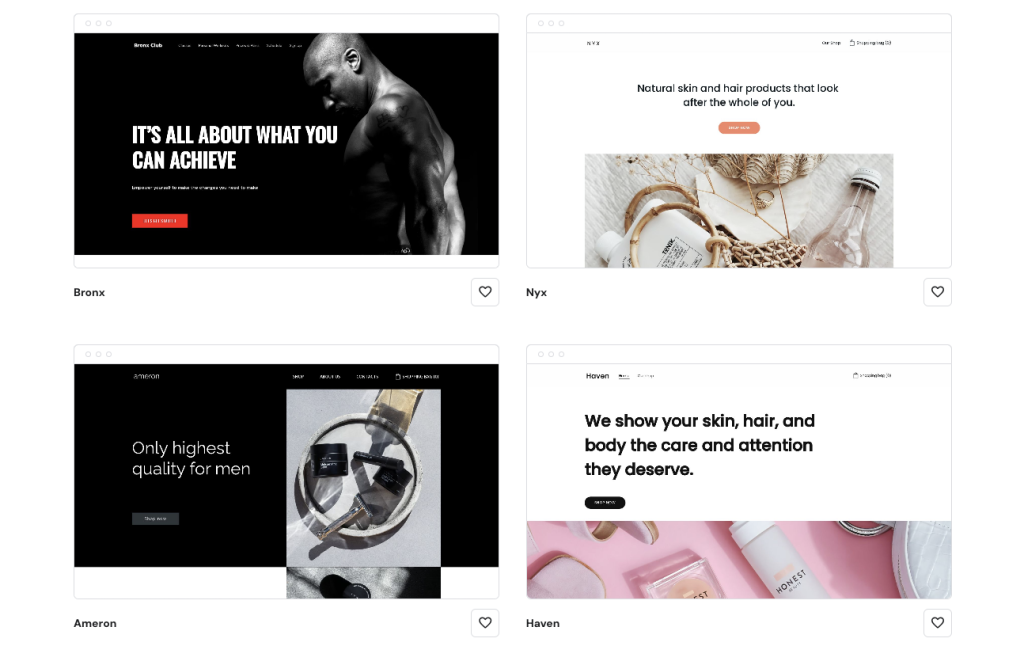
Preview the template with placeholder content to see how the design looks.

When you find a template you like, click on Start building. This opens the drag-and-drop editor, where you can personalize your template by adjusting colors, fonts, and layout to match your brand.
Remember that you can add a blog to any website template with just a few clicks, so you don’t have to limit yourself to certain types of designs, either.
You can also use the AI builder to create a unique website.
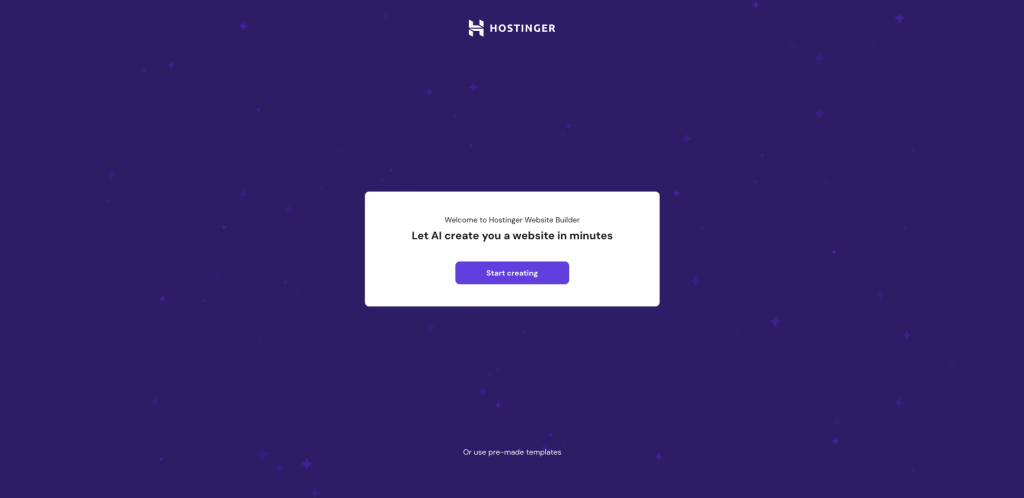
Simply answer a few questions regarding your website and brand, and the AI will create a fully-fledged website based on your answers. Once ready, you can still adjust everything in the website editor before publishing.
6. Customize Your Blog
Customization makes your blog unique and enhances the user experience, helping you build a loyal audience.
A well-customized blog can improve reader engagement, increase time spent on your site, and boost your blog’s overall performance.
Customize the Navigation Menu
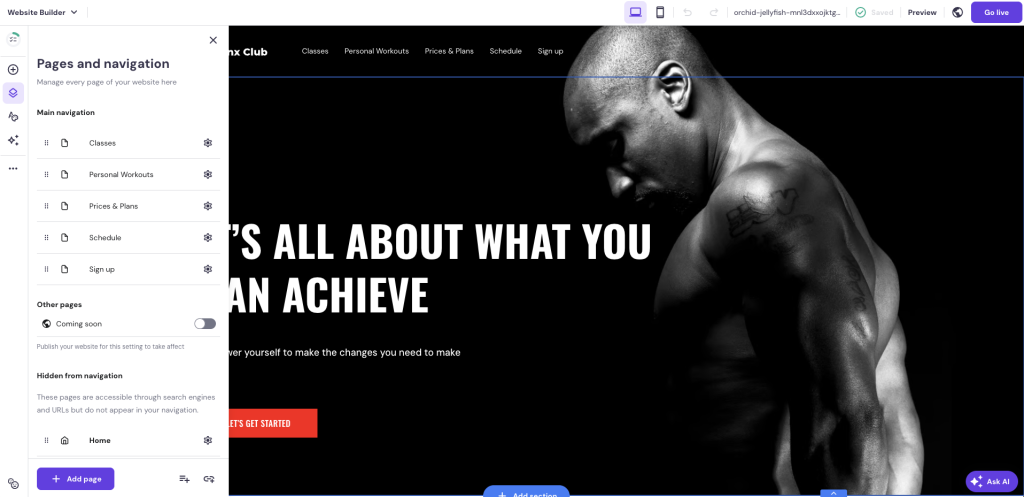
Create a clear and intuitive navigation menu to help readers find content easily. Add, remove, or rename menu items to reflect the main sections of your blog.
Consider including categories like Home, About, Blog, Contact, and any specific sections relevant to your health niche, such as Meal Plans or Fitness Tips.
Personalize Colors and Fonts
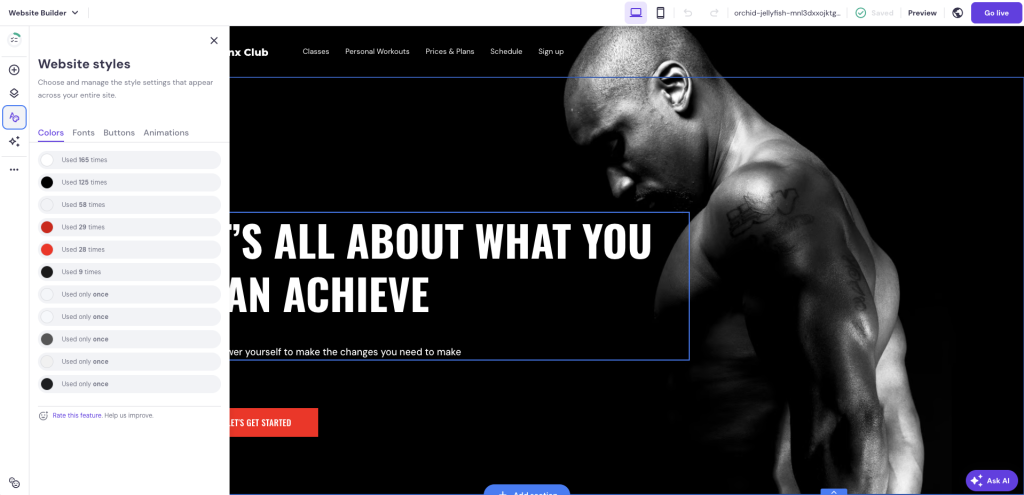
Adjusting your blog’s colors and fonts is a simple yet effective way to align the design with your brand identity. Choose a color scheme that reflects your blog’s theme and personality.
Ensure the fonts are easy to read and consistent throughout your site. The website editor makes it easy to change these elements with just a few clicks.
Create Custom Graphics and Images
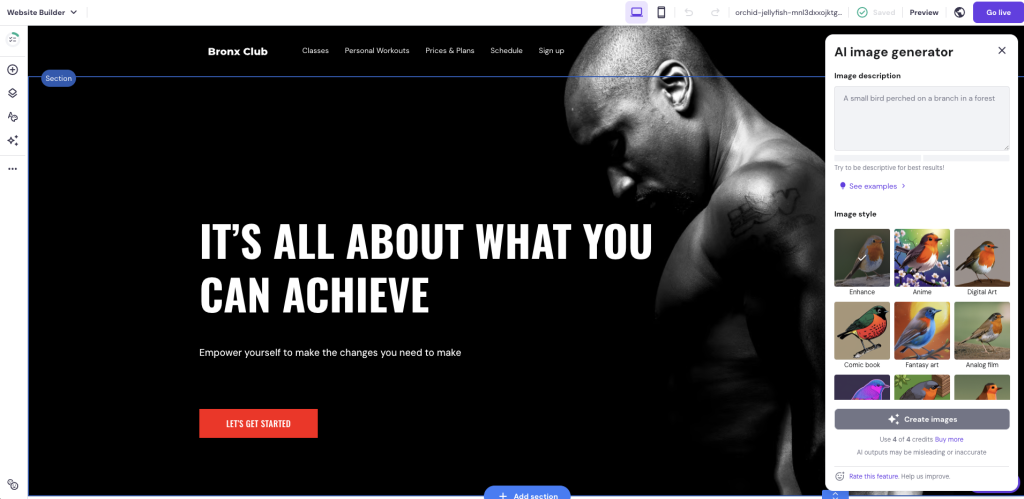
Incorporate custom graphics and images to make your blog visually appealing.
Hostinger’s AI Image Generator can help you create unique visuals tailored to your content. This tool is especially useful if you don’t have graphic design skills. Simply describe the type of image you want, and the AI will generate professional-looking visuals for your blog.
Optimize the Page Layout
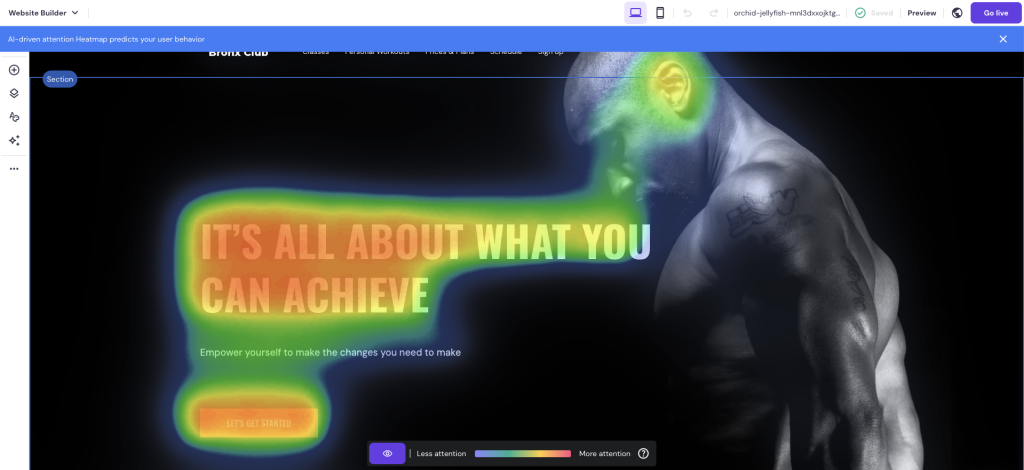
Focus on creating a user-friendly page layout that enhances readability and engagement. Break up long blocks of text with headings, subheadings, and bullet points. Use ample white space to give your content room to breathe and make it easier for readers to focus.
Ensure that important elements like call-to-action buttons and key information are easily accessible. Use the AI Heatmap to analyze the page layout and adjust accordingly.
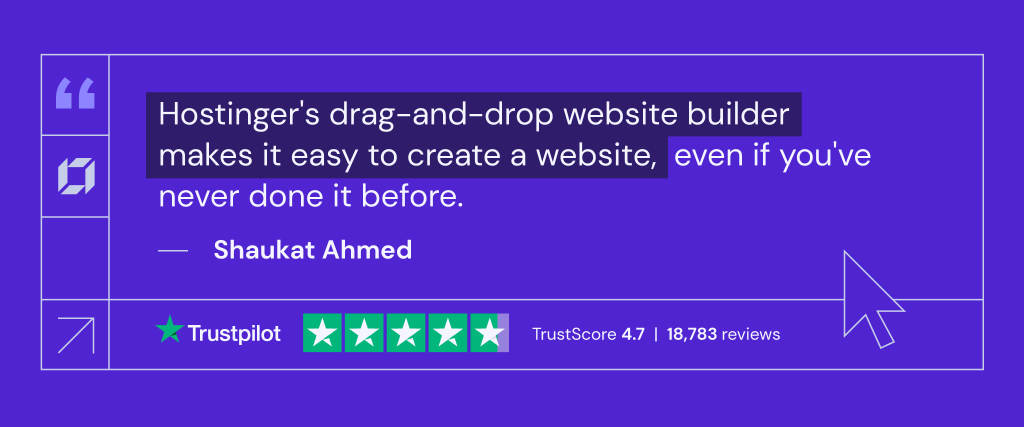
7. Write Engaging Content
Consistent, high-quality content is the backbone of a successful blog. It attracts and retains readers, drives traffic, and establishes your authority in the health niche.
Engaging content can lead to more shares and better search engine rankings, ultimately growing your blog’s audience and influence. Here’s how to create engaging content:
Utilize AI Writing Tools

AI writing tools like Hostinger’s AI Writer can help you generate high-quality content quickly and efficiently. These tools can assist you in brainstorming topics, drafting posts, and even optimizing your content for SEO. Here’s how to make the most of AI writing tools:
- Topic generation. Use AI to generate new topic ideas based on current trends and audience interests. This can help you keep your content fresh and relevant.
- Content drafting. AI can help you draft content by providing suggestions and structuring your posts. This can save you time and help you overcome writer’s block.
- Unique content. All content created by Hostinger AI Writer is unique and SEO-friendly.
Content Planning
Creating a content calendar is essential for planning and scheduling your posts regularly. This helps you stay organized and ensures you consistently publish new content.
Start by brainstorming topics that are relevant to your niche and audience. Plan your content around key dates, such as health awareness days or seasonal trends, to keep your blog timely and relevant.
Using tools like Google Calendar or Trello can help you manage your schedule and stay on top of your posting routine.
Storytelling
Using personal stories and experiences can help you connect with your readers on a deeper level.
Share your health journey, challenges, and successes to create relatable content that resonates with your audience. Storytelling can make your blog more engaging and memorable, encouraging readers to return for more.
Visuals
Incorporating visuals such as images, infographics, and videos can make your posts more appealing and easier to understand. Visuals can break up long blocks of text, making your content more digestible.
Use high-quality images and create custom graphics to illustrate your points and enhance the overall reading experience.
Actionable Advice
Providing practical tips and steps that readers can follow to achieve their health goals is crucial. Your content should offer value by giving readers clear, actionable advice they can implement in their own lives.
Whether it’s a step-by-step guide to starting a new fitness routine or tips for healthy eating, actionable advice helps build trust and credibility with your audience.
8. Optimize Your Blog Content for Search Engines
Search engine optimization helps your blog rank higher in search engine results, making it easier for readers to find your content.
Higher search engine rankings lead to increased visibility, more organic traffic, and greater opportunities for monetization. Here’s how to effectively optimize your blog content for search engines:
Utilize SEO Tools

Hostinger Website Builder’s built-in SEO dashboard has been designed to make optimization straightforward and effective. Here, you can identify and implement necessary SEO practices while maintaining a good overview of your whole blog.
Start by customizing the meta titles and descriptions for each page and blog post to include relevant keywords. Meta descriptions should be concise, informative, and encourage clicks.
For example:
- Title – 10 Benefits of Yoga for Beginners.
- Meta title – Top 10 Benefits of Yoga for Beginners – Improve Your Health.
- Meta description – Discover the top 10 benefits of yoga for beginners. Learn how yoga can improve your flexibility, reduce stress, and enhance overall well-being. Click to read more!
Use clean, descriptive URLs that include your primary keyword to help search engines understand your page’s content. For instance, instead of using a URL like www.yourblog.com/post1, use www.yourblog.com/yoga-benefits-beginners.
Follow YMYL (Your Money or Your Life) Guidelines
For health-related topics, adhering to YMYL guidelines is crucial to ensure your content is credible and trustworthy. Search engines like Google prioritize high-quality, reliable content in these areas.
Clearly state the credentials and expertise of your content authors to build trust with your readers and search engines. Reference reputable sources and include citations for any data or claims you present in your content.
Update your content regularly to ensure it remains accurate and relevant. Outdated information can negatively impact your credibility and search rankings.
Incorporate Keywords and Meta Descriptions
Keywords are words and phrases your potential readers are searching for. Including them in your content helps search engines understand what your post is about and match it to relevant searches.
Use tools like Google Keyword Planner, Ahrefs, or SEMrush to find relevant keywords for your niche. Focus on long-tail keywords that have lower competition but are highly relevant to your audience. Add these keywords naturally into your blog post titles, headings, and throughout the content.
Avoid keyword stuffing, which can harm your SEO. Write compelling meta descriptions that include your primary keyword and provide a brief overview of the post’s content. This can improve your click-through rate from search results.
Use Descriptive Alt Texts for Images
Alt texts (alternative texts) describe the content of images. This not only improves website accessibility for visually impaired users but also helps search engines index your images properly.
Write descriptive alt texts that accurately represent the image content and include relevant keywords where appropriate. Ensure the alt text adds value to the content of the post and is contextually relevant.
This helps search engines understand how the image relates to your blog content.
Optimize Content for Readability
Readable content is more engaging and easier for your audience to consume, which can positively impact your SEO.
Break up your content with clear, descriptive subheadings. This not only improves readability but also helps search engines understand the structure of your content.
Write short, concise paragraphs to make your content more digestible. Long blocks of text can be overwhelming and discourage readers. Use bullet points and lists to highlight key information and make your content more scannable.
9. Promote Your Health Blog
Effective promotion of your new health and wellness blog is essential for reaching a wider audience and growing your blog’s readership. Increased traffic leads to higher engagement rates and more opportunities for monetization and collaboration.
Below are some actionable and beginner-friendly ideas for promoting your wellness blog:
Social Media
Sharing your blog posts on social media platforms is one of the most effective ways to attract more readers.
Start by creating profiles on major social media networks like Facebook, Instagram, X, and Pinterest. Post regularly and share not only your blog content but also other valuable information related to your niche to keep your audience engaged.
Tips
- Use hashtags relevant to your niche to increase the visibility of your posts.
- Join groups and communities on platforms like Facebook and Reddit where your target audience is active, and share your blog posts there.
Guest Blogging
Writing guest posts for other health blogs can significantly increase your exposure.
Research and identify popular blogs within your niche that accept guest contributions. Pitch them with well-thought-out ideas that will provide value to their readers and link back to your blog.
Tips
- Start by creating a list of blogs you’d like to contribute to and draft personalized outreach emails for each one.
- To drive traffic back to your site, include a short bio with a link to your blog in each guest post.
Communicate With Readers
Building a loyal audience involves communicating with them.
Respond to their comments on your blog and social media posts to create a sense of community. Starting a newsletter is another excellent way to keep your readers informed and engaged.
Tips
- Create and manage your email list using tools like Mailchimp or ConvertKit. To encourage sign-ups, offer a freebie, such as an eBook or a printable.
- Ask for feedback and suggestions from your readers to make them feel valued and involved in your blog’s growth.
Networking
Connecting with other bloggers and participating in health-related communities can help build relationships and increase your blog’s visibility.
Attend virtual or in-person conferences, join online forums, and engage in discussions on platforms like LinkedIn.
Tips
- Collaborate with other bloggers for joint projects like webinars, challenges, or giveaways to reach a broader audience.
- Share and comment on other bloggers’ content to build rapport and encourage them to reciprocate.
Paid Advertising
Consider investing in paid advertising to quickly boost your blog’s visibility.
Platforms like Google Ads, Facebook Ads, and Instagram Ads can target specific demographics and interests, ensuring your blog reaches the right audience.
Tips
- Start with a small budget to test different ad formats and strategies. Analyze the results and adjust your campaigns accordingly.
- Use eye-catching images and compelling copy in your ads to increase click-through rates.
10. Monetize Your Health Blog
Monetizing your health and wellness blog helps you to earn side income, making your blogging journey both sustainable and rewarding.
Affiliate Marketing
Affiliate marketing is a popular and effective way to earn income by promoting products and earning a commission on sales generated through your referral links.
To get started, choose health-related products that align with your blog’s niche and would be genuinely beneficial to your audience. This could include fitness equipment, nutritional supplements, or wellness apps.
Once you’ve identified the right products, join affiliate programs like Amazon Associates or ShareASale or work directly with brands you love.
When incorporating affiliate links into your blog, ensure they fit naturally within your content. Write product reviews, create recommendation lists, or mention products within relevant blog posts.
Transparency is key, so always disclose your affiliate relationships to maintain trust with your audience and comply with legal requirements.
Sponsored Posts
Collaborating with brands to create sponsored content can be a lucrative way to monetize your blog while providing value to your audience.
Start by building a significant and engaged audience, as brands are more likely to sponsor bloggers with a strong following. Reach out to companies that align with your niche and offer to create sponsored content, highlighting your blog’s engagement metrics and how you can add value to their brand.
When creating sponsored posts, ensure that the content is genuine and beneficial to your readers. Integrate the brand’s message in a way that feels natural and informative.
It’s also important to set clear terms with the sponsoring brand, agreeing on deliverables, deadlines, and payment terms. Drafting a contract can help formalize the agreement and avoid any misunderstandings.
Digital Products
Selling digital products such as eBooks, online courses, and printables can generate passive income and establish you as an authority in your niche.
Begin by identifying your audience’s specific needs and interests. Create products that address these needs, such as an eBook on meal planning, a yoga course for beginners, or printable workout routines.
Invest time in creating high-quality digital products, using tools like Canva for design or platforms like Teachable for online courses.
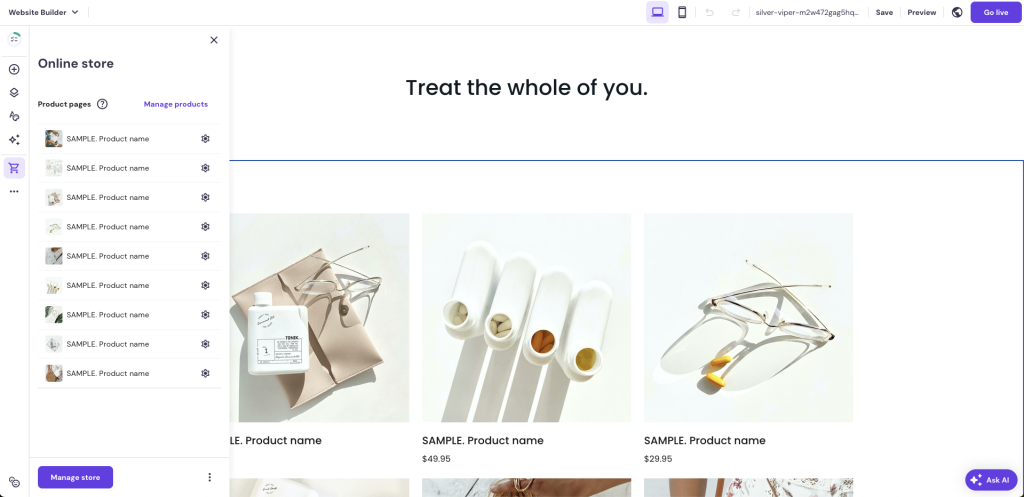
Once your products are ready, you can sell them directly through your blog using Hostinger Website Builder’s online store feature. Here’s a step-by-step guide to setting up your online store:
- Set up your store. Add an online store easily to your blog by navigating to the side menu in the website editor and select Online store → Add store.
- Add your products. Upload your digital products, set prices, and write compelling product descriptions that highlight the benefits.
- Set up shipping and payment processing. Use the built-in tools to manage inventory, process payments, and track sales.
- Promote your store. Drive traffic to your online store by featuring products in your blog posts, social media channels, and email campaigns. Offering discounts or free previews can entice your audience to make a purchase.
Conclusion
Starting a health and wellness blog enables you to share your passion, help others achieve their health goals, and establish yourself as an authority in the field.
By understanding your audience, selecting the right blogging platform, choosing a specific niche, and optimizing your content for search engines, you can create a successful blog that attracts and retains readers.
Effective promotion and monetization strategies will further enhance your blog’s reach and sustainability.
With the right tools, you can build a thriving health blog that makes a positive impact on your readers’ lives.
How to Start a Health Blog FAQ
Find answers to the most commonly asked questions about how to start a health blog below.
Do I Need a License to Be a Blogger?
No, you do not need a license to be a blogger. However, it’s essential to comply with any relevant laws and regulations, especially when offering health advice.
Do I Need Any Technical Knowledge to Start a Health Blog?
No, you don’t need any technical knowledge to start a health blog. Platforms like Hostinger Website Builder provide user-friendly tools and templates that make it easy for beginners to create and manage their blogs.
What Are the Common Mistakes to Avoid When Starting a Health Blog?
Common mistakes include neglecting SEO, inconsistent posting schedules, and failing to engage with your audience. Focus on creating valuable content, optimizing for search engines, and building a community around your blog.



